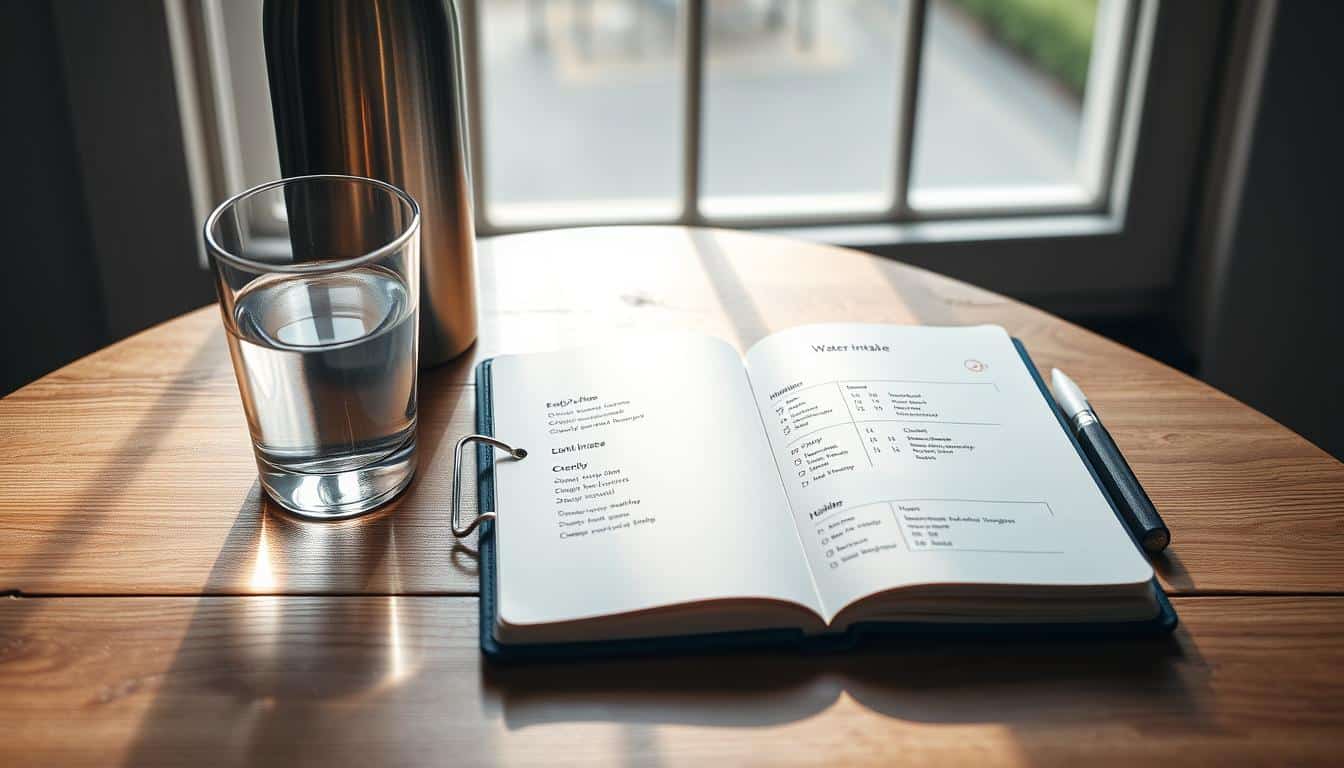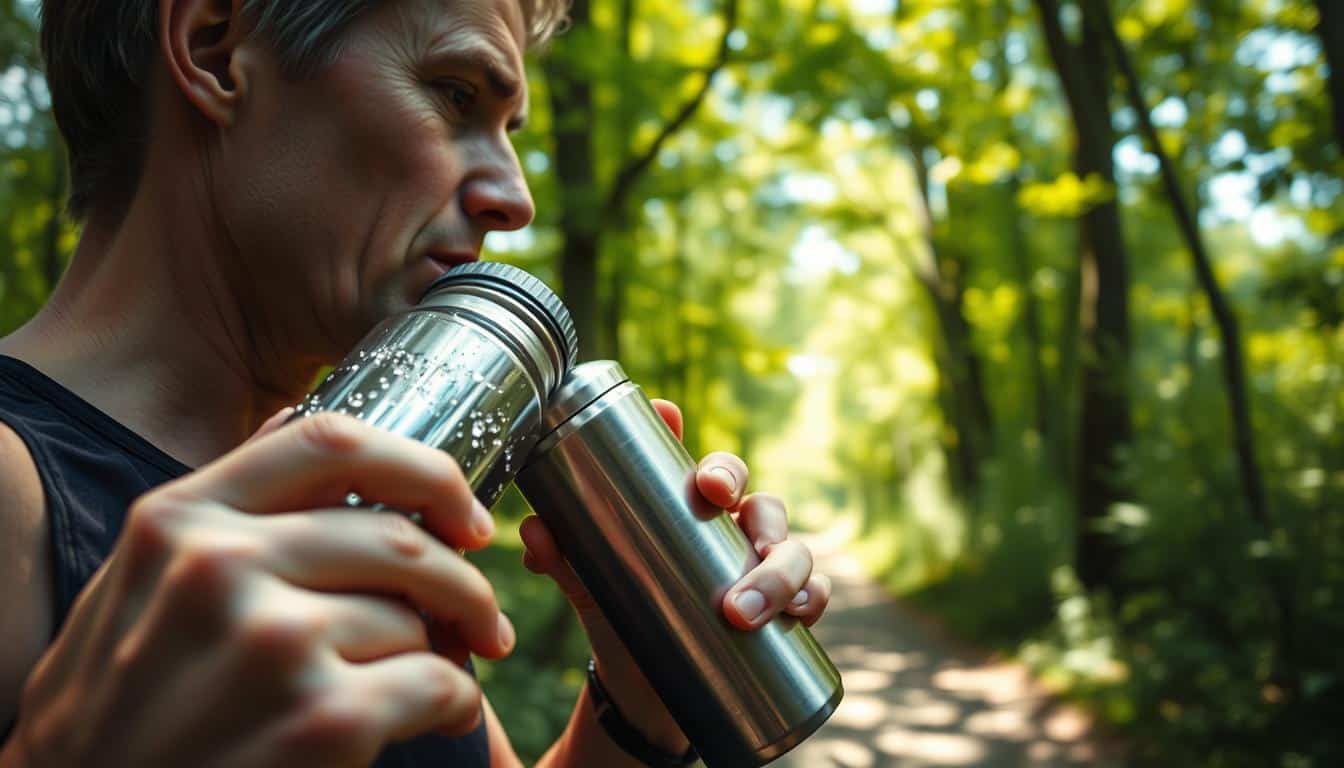Nearly 60% of your body is water—and even small loss slows you down. That fact matters when you lace up. Losing fluid during exercise thickens blood and cuts oxygen to muscles. You feel fatigue sooner and pace slips.
This short guide gives clear steps you can use today. I’ll show a simple daily plan, how to prep before a run, when to sip during a run, and how to recover after. No guesswork. Just practical, science-backed advice you can fit into a busy day.
You want exact amounts and simple checks. I’ll explain signs to adjust intake on the fly and a quick urine-color check that works like a low-tech gauge. You’ll learn the effects of poor fluid balance and easy ways to keep joints, blood flow, and temperature control working for your health and pace.
Ready to make drinking part of your routine? Keep reading. This guide turns small steps into steady gains on every run.
Why hydration matters for performance and health
Fluid balance affects how you feel and how fast you move on any run. Keep levels steady and your body will cool better, deliver oxygen, and resist early fatigue.
How fluid loss affects blood, temperature, and fatigue
When you lose water during exercise, blood gets thicker. Thicker blood limits oxygen delivery to muscles. That makes your legs tire sooner and your pace drop.
About 75% of exercise energy becomes heat. If fluid is low the body can’t shed heat as well. Core temperature and heart rate rise. That raises risk of heat illness and hurts focus.

- Dark yellow urine, dry mouth, or headaches are clear signs of low fluid.
- Fatigue, poor coordination, or slower-than-usual performance are warning signals.
- If you feel dizzy or can’t concentrate, pause and address fluid loss quickly.
A quick urine check before a session is useful—aim for a pale lemonade color. Plan extra water and cooling breaks on hot or humid days. Read more myths and science in this short guide.
Set a daily hydration plan you can follow
Pick a simple daily plan you can actually stick to every day. Choose a target that fits your size and training. Women: ~91 oz daily. Men: ~125 oz daily. These totals include beverages and water-rich foods.

Spread the goal evenly throughout day. Use a small number like 8 oz every two hours. That pattern reaches about 120 oz across 15 waking hours. It keeps drinking steady and avoids giant gulps.
Carry one marked bottle and refill it. Set phone timers to nudge sips. Tie a drink to routine events—emails, meetings, or before a workout. Add high-water foods such as watermelon and strawberries with meals.
- Plan an extra glass with each training session.
- People in hot or dry spaces may need more; check urine color.
- Keep a quick note in your guide or app with your target number and refill count.
| Target | Daily oz | Simple pattern | Tracking |
|---|---|---|---|
| Women | ~91 oz | 8 oz every 2–3 hours | Marked bottle + refill count |
| Men | ~125 oz | 8–10 oz every 2 hours | Timers + bottle tally |
| Practical example | ~120 oz | 8 oz × 15 hours | Phone reminders + high-water snacks |
Hydration tips for runners before you lace up
Plan a short pre-run drink routine so you start steady and comfortable.
Drink 17 to 20 oz of water a few hours before exercise. That gives your body time to absorb fluid.
Add 8 oz about 20 to 30 minutes before the run or during your warm-up. This tops off your stores without slosh.
- Sip a glass at bedtime and one on waking for early runs. Keep amounts small to avoid discomfort.
- Don’t chug a large amount right before you go. Big gulps can slow you down and cause cramps.
- If you ate salty food last night, add a pinch of salt to your pre-run water to aid uptake.
- Make sure you plan bathroom time in the last 30 minutes so you start relaxed.
- Adjust amounts when it’s hot or humid—heat raises sweat from the first minute.
- Practice this routine in training so race day drinking feels automatic.
| When | Amount | Why |
|---|---|---|
| 2–3 hours before | 17–20 oz | Allows absorption and steady blood volume |
| 20–30 minutes before | 8 oz | Top-off without stomach slosh |
| Night & wake (early runs) | Small sips (4–8 oz total) | Prevents overnight loss and avoids discomfort at start |
Hydrate smart during your run
Keep your sip plan simple: small, steady drinks beat big gulps. Aim to sip about 4–8 oz of water every 15 to 20 minutes. Move toward 8 oz when pace or heat rises. This helps steady fluid and prevents stomach slosh.
How much to drink every 15 to 20 minutes
Use 4–8 oz every 15–20 minutes as your baseline. If you’re working hard or the heat is high, pick the top of that range.
Electrolytes and sodium: when plain water is not enough
For sessions over 45 minutes at a high intensity or in heavy heat, add electrolytes. Sodium helps you absorb fluid and replace what sweat loses. Pick a sports drink you’ve tested in training, not first at a race.
Heat, longer distance, and individual sweat rates
Most people sweat 400–2400 ml per hour. Max absorption is roughly 750 ml/hour (up to 1 L for larger athletes). Learn your sweat pattern in training and plan how much water you aim to finish each hour.
Avoid overhydration: symptoms and simple checks
Watch for sloshy stomach, nausea, dizziness, or confusion. If you see those, slow intake and add some sodium. In long races, drink to thirst and track cups at aid stations so you don’t over- or under-drink.
Quick guide
- Sip ~4–8 oz every 15–20 minutes; choose larger amounts in heat or hard efforts.
- One to two good swigs at each watch buzz keeps intake steady.
- Add electrolytes when heat, pace, or distance exceed ~45 minutes.
| Situation | Recommended fluid | Electrolyte note |
|---|---|---|
| Easy run <45 min | 4–6 oz every 15–20 minutes | Water fine; no extra sodium needed |
| Hard run or heat >45 min | 6–8 oz every 15–20 minutes | Add sports drink or salt to aid absorption |
| Long race or high sweat | Plan hourly target; track cups taken | Use tested sports drinks and replace sodium |
Recover right: after-run hydration that works
Post-run recovery starts with a simple weigh-in and a plan to replace lost fluid.
Weigh yourself naked or in light clothes just before you run. Towel off sweat and weigh again within five minutes after you finish.
Use the difference in weight to find the pounds lost. For each pound lost, drink about three cups of water to replace fluid.
Steps and timing
- Record pre-run weight and post-run weight to get the exact number lost.
- Multiply pounds lost by three to get cups of water to drink.
- Finish most replacement within 1.5 to 2 hours for faster recovery.
Quick checks and extras
Urine color is a simple, number-free check. Aim for a pale lemonade color by the end of the day.
- Add a pinch of salt or an electrolyte drink after hot or long sessions to help retain fluid.
- Make sure your first meal includes water-rich foods and a glass of water.
- If you still feel thirsty or crampy, keep sipping small amounts until urine lightens.
- Log weight changes and cups consumed after key runs to refine your plan.
| Measure | Action | Target timing |
|---|---|---|
| Weight loss (lbs) | Drink ~3 cups per lb lost | Within 1.5–2 hours |
| Urine color | Pale lemonade = good | By end of day |
| Hot or long session | Add electrolytes or a pinch of salt | Immediately after run and during 2-hour window |
Hydration gear and carry options for runs and races
Match your bottle and pack to the distance and the aid layout of the course.
Bottles and soft flasks: handheld and pocket choices
Handheld bottles are the simplest option for short runs. They give easy access and steady balance.
Soft flasks like the Salomon Soft Flask 250ml or Maurten Drinkflask 550ml collapse as you drink. That reduces slosh and fits tight pockets.
Vests and backpacks: capacity, fit, and access
Hydration vests put small bottles up front. That makes gels and water reachable without slowing.
Try Salomon Sense Pro 6 Set or OMM UltraFire 5 Vest for a snug fit and quick access.
Backpacks with bladders suit longer distance needs. Choose models with >1.5 L capacity like Salomon Trailblazer or OMM Classic 18.
Waist packs and race aid stations: what to carry and what to grab
Waist packs are low-profile and carry a small bottle, gels, and your phone. Fitletic Hydration Belt and Salomon Pulse Belt are good picks.
Study the race map and plan which aid stations you’ll use. Don’t test new gear on race day—practice in training instead.
- Quick picks: handheld for short runs; soft flasks for low bounce; vests for front access; backpacks for long distance.
- Check fit when loaded. People move differently; a proper fit prevents rub and helps you relax.
- Plan what to carry vs. what to grab at aid stations. That’s the easiest way to balance water and weight.
| Carry type | Best use | Example |
|---|---|---|
| Handheld / soft flask | Short runs, low bounce | Salomon Soft Flask 250ml, Maurten 550ml |
| Vest | Hilly or medium-length runs, easy access | Salomon Sense Pro 6 Set, OMM UltraFire 5 Vest |
| Backpack / bladder | Long distance, >1.5 L need | Salomon Trailblazer, OMM Classic 18 |
Conclusion
Use simple, testable numbers to keep your body steady during training and races.
Set a daily target and keep a bottle close to make each water drink easy throughout day.
Before a session, take 17–20 oz a few hours ahead, then 8 oz about 20–30 minutes before the start.
On the move, sip about 4–8 oz every 15–20 minutes. Increase intake in heat or with harder effort and add electrolytes and sodium when sessions exceed about 45 minutes.
After exercise, weigh yourself and replace roughly three cups per pound lost within 1.5–2 hours. Use urine color as a quick check of recovery.
Plan gear and aid stops in a race and track numbers with sweat checks. If you want product options, see the best hydration drinks.
Stick with this guide, refine amounts with practice, and adjust fast when signs of dehydration or overhydration appear. You’ll feel the difference on every run.


